In order to compute the warping, you need to compute a homography between the four corners of your input rectangle and the screen.
Since your webcam polygon seems to have an arbitrary shape, a full perspective homography can be used to convert it to a rectangle. It's not that complicated, and you can solve it with a mathematical function (should be easily available) known as Singular Value Decomposition or SVD.
Background information:
For planar transformations like this, you can easily describe them with a homography, which is a 3x3 matrix H such that if any point on or in your webcam polygon, say x1 were multiplied by H, i.e. H*x1, we would get a point on the screen (rectangular), i.e. x2.
Now, note that these points are represented by their homogeneous coordinates which is nothing but adding a third coordinate (the reason for which is beyond the scope of this post). So, suppose your coordinates for X1 were, (100,100), then the homogeneous representation would be a column vector x1 = [100;100;1] (where ; represents a new row).
Ok, so now we have 8 homogeneous vectors representing 4 points on the webcam polygon and the 4 corners of your screen - this is all we need to compute a homography.
Computing the homography:
A little math:
I'm not going to get into the math, but briefly this is how we solve it:
We know that 3x3 matrix H,
H =
h11 h12 h13
h21 h22 h23
h31 h32 h33
where hij represents the element in H at the ith row and the jth column
can be used to get the new screen coordinates by x2 = H*x1. Also, the result will be something like x2 = [12;23;0.1] so to get it in the screen coordinates, we normalize it by the third element or X2 = (120,230) which is (12/0.1,23/0.1).
So this means each point in your webcam polygon (WP) can be multiplied by H (and then normalized) to get your screen coordinates (SC), i.e.
SC1 = H*WP1
SC2 = H*WP2
SC3 = H*WP3
SC4 = H*WP4
where SCi refers to the ith point in screen coordinates and
WPi means the same for the webcam polygon
Computing H: (the quick and painless explanation)
Pseudocode:
for n = 1 to 4
{
// WP_n refers to the 4th point in the webcam polygon
X = WP_n;
// SC_n refers to the nth point in the screen coordinates
// corresponding to the nth point in the webcam polygon
// For example, WP_1 and SC_1 is the top-left point for the webcam
// polygon and the screen coordinates respectively.
x = SC_n(1); y = SC_n(2);
// A is the matrix which we'll solve to get H
// A(i,:) is the ith row of A
// Here we're stacking 2 rows per point correspondence on A
// X(i) is the ith element of the vector X (the webcam polygon coordinates, e.g. (120,230)
A(2*n-1,:) = [0 0 0 -X(1) -X(2) -1 y*X(1) y*X(2) y];
A(2*n,:) = [X(1) X(2) 1 0 0 0 -x*X(1) -x*X(2) -x];
}
Once you have A, just compute svd(A) which will give decompose it into U,S,VT (such that A = USVT). The vector corresponding to the smallest singular value is H (once you reshape it into a 3x3 matrix).
With H, you can retrieve the "warped" coordinates of your widget marker location by multiplying it with H and normalizing.
Example:
In your particular example if we assume that your screen size is 800x600,
WP =
98 119 583 569
86 416 80 409
1 1 1 1
SC =
0 799 0 799
0 0 599 599
1 1 1 1
where each column corresponds to corresponding points.
Then we get:
H =
-0.0155 -1.2525 109.2306
-0.6854 0.0436 63.4222
0.0000 0.0001 -0.5692
Again, I'm not going into the math, but if we normalize H by h33, i.e. divide each element in H by -0.5692 in the example above,
H =
0.0272 2.2004 -191.9061
1.2042 -0.0766 -111.4258
-0.0000 -0.0002 1.0000
This gives us a lot of insight into the transformation.
[-191.9061;-111.4258] defines the translation of your points (in pixels)[0.0272 2.2004;1.2042 -0.0766] defines the affine transformation (which is essentially scaling and rotation).- The last
1.0000 is so because we scaled H by it and
[-0.0000 -0.0002] denotes the projective transformation of your webcam polygon.
Also, you can check if H is accurate my multiplying SC = H*WP and normalizing each column with its last element:
SC = H*WP
0.0000 -413.6395 0 -411.8448
-0.0000 0.0000 -332.7016 -308.7547
-0.5580 -0.5177 -0.5554 -0.5155
Dividing each column, by it's last element (e.g. in column 2, -413.6395/-0.5177 and 0/-0.5177):
SC
-0.0000 799.0000 0 799.0000
0.0000 -0.0000 599.0000 599.0000
1.0000 1.0000 1.0000 1.0000
Which is the desired result.
Widget Coordinates:
Now, your widget coordinates can be transformed as well H*[452;318;1], which (after normalizing is (561.4161,440.9433).
So, this is what it would look like after warping:

As you can see, the green + represents the widget point after warping.
Notes:
- There are some nice pictures in this article explaining homographies.
- You can play with transformation matrices here
MATLAB Code:
WP =[
98 119 583 569
86 416 80 409
1 1 1 1
];
SC =[
0 799 0 799
0 0 599 599
1 1 1 1
];
A = zeros(8,9);
for i = 1 : 4
X = WP(:,i);
x = SC(1,i); y = SC(2,i);
A(2*i-1,:) = [0 0 0 -X(1) -X(2) -1 y*X(1) y*X(2) y];
A(2*i,:) = [X(1) X(2) 1 0 0 0 -x*X(1) -x*X(2) -x];
end
[U S V] = svd(A);
H = transpose(reshape(V(:,end),[3 3]));
H = H/H(3,3);
A
0 0 0 -98 -86 -1 0 0 0
98 86 1 0 0 0 0 0 0
0 0 0 -119 -416 -1 0 0 0
119 416 1 0 0 0 -95081 -332384 -799
0 0 0 -583 -80 -1 349217 47920 599
583 80 1 0 0 0 0 0 0
0 0 0 -569 -409 -1 340831 244991 599
569 409 1 0 0 0 -454631 -326791 -799

